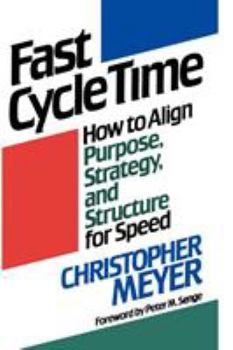Fast Cycle Time: How to Align Purpose, Strategy, and Structure for Speed
Select Format
Select Condition 
Book Overview
Today, tens of thousands of companies are struggling to become "time-based" competitors, inspired by such corporations as Motorola, General Electric, Citicorp, and a myriad of others who have cut production time in half--or more. But until now, the literature has focused on the theory and philosophy of fast cycle time, rather than the tools and techniques for implementing it. Here, for the first time, Christopher Meyer, an internationally recognized expert in cycle time reduction, presents a step-by-step blueprint for transforming traditional companies into fast cycle competitors. Meyer argues that fast cycle time is achieved not by working faster, but by aligning the organization's purpose, strategy and structure. He demonstrates how the product development cycle must become a learning laboratory in which the four continuous elements "Design, Fabricate, Assemble, and Test" are analyzed with the intent to improve strategy in the next business cycle. Analyzing strategy and core processes enables management to detect and correct problems earlier, and leverage knowledge for improved innovation and increased value for customers. Employing an ongoing case study, Core Products, Inc., throughout the text, Meyer shows how to redesign the organization for manufacturability and assembly, how to implement multifunctional teams that work, how to analyze and map critical cycle time interdependencies such as "co-location," and how to measure the impact of cycle time on business performance. Meyer's practical approach provides a simple methodology for organizations to deliver products to customers rapidly, accurately, and reliably. "Chris Meyer interrelates many pieces that we have all read about in different places into a coherent guide to making it happen. Ironically, as Meyer shows, implementing fast cycle time means almost the opposite of what most American managers are inclined to do...Many years of practical experience have shown Meyer and his colleagues the wisdom of a paradox--that to speed up you often have to slow down." --From the Foreword by Peter M. Senge
Format:Paperback
Language:English
ISBN:141657624X
ISBN13:9781416576242
Release Date:September 2007
Publisher:Free Press
Length:292 Pages
Weight:1.15 lbs.
Dimensions:0.8" x 6.0" x 9.0"
Customer Reviews
3 ratings
Excellent pre-lean introduction to improving development
Published by Thriftbooks.com User , 17 years ago
Fast Cycle time was written in 1993, though his ideas are very much inline with the "modern" lean ideas (concept introduces in 1990). The book explains how to improve cycle time in product development and how this will lead to a general improvement within the company. The book consists of two parts. The first part describes the fast cycle time concepts. It introduces cross-functional teams (which the author calls multifunctional teams). Most importantly it links the speed of development to the speed of learning since product development is equal to learning (very much inline with Al Ward's "Lean Product Development" ideas). It links his ideas back to the learning organization theories and shows how these concepts are an absolute must when speeding up product development. The second part is about the implementation of these concepts. First it talks about making a clear strategy so that the organization can focus. After that, one of the main topics of the book, is the multifunctional team chapter. This introduces the concepts and talks about the different organizational models. Also it'll go over the typical development of multifunctional teams. The next chapter covers process redesign. This chapter is very similar to lean's "value steam mapping" ideas (well, exactly the same to be precise). Though Chris Meyer uses process maps instead of value stream maps. The book ends with some guidance on implementation of these ideas. The book was well written and very clear. There is a balance between examples and theory. The CP (Quantum?) example wasn't worked out that well. Anyways, I thoroughly enjoyed reading this book. It's one of the only books which has a strong focus on cross-functional teams and it's relation to cycle time and organization learning. Recommended.
Cross functional alignment is the key . . .
Published by Thriftbooks.com User , 22 years ago
Many of our clients are struggling with life at internet speeds. If you haven't read this classic on speeding up your organizations product and service life cycle, now may be a good time to do so. Praise for this book, as listed on the back of the dust jacket, come from Ford Motor Company, Quantum Corporation and others with Ed McCraken, CEO of Silicon Graphics Computer Systems stating that this is; "A must read for executive who seek speed and competitiveness."Mr. Meyer utilizes an "ongoing case study" to make his points concerning FCT processes. This approach lends credence to his positions and gives the book a solid feel of practicality. In addition, frequent use of diagrams helps the reader visualize the organizations, processes, information flow, and cross functional activities of organizations. The layout of the book is logical and provides for continuity as Meyer builds on each preceding chapter.The book is filled with excellent observations and pithy sayings: "The responsibility for strategic alignment rests with senior management." "Any organization leader who seeks to 'empower' people should first create a clear strategic context that enables others to use the power with which they were born." "Research demonstrates there is a negative correlation between economic growth rate and the number of Nobel prizes won." "A sustainable FCT capability can be achieved only by learning faster, not by working faster."
Time is worth more than it used to be
Published by Thriftbooks.com User , 25 years ago
This book provides a compelling blend of theory and practical advice on how to move quickly. I found many things that used combined Balanced Score Card techniques focused on cycle time with the author's real world experience - which is considerable.The book is aimed at managing the culture and mindset of the organization, not a particular project. A worthwhile read if time-based-competition applies to your business.






